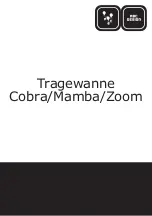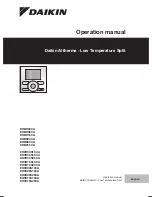
5-206
T60 Transformer Protection System
GE Multilin
5.6 GROUPED ELEMENTS
5 SETTINGS
5
•
POWER SWING MODE:
This setting selects between the two-step and three-step operating modes and applies to
both power swing blocking and out-of-step tripping functions. The three-step mode applies if there is enough space
between the maximum load impedances and distance characteristics of the relay that all three (outer, middle, and
inner) characteristics can be placed between the load and the distance characteristics. Whether the spans between
the outer and middle as well as the middle and inner characteristics are sufficient should be determined by analysis of
the fastest power swings expected in correlation with settings of the power swing timers.
The two-step mode uses only the outer and inner characteristics for both blocking and tripping functions. This leaves
more space in heavily loaded systems to place two power swing characteristics between the distance characteristics
and the maximum load, but allows for only one determination of the impedance trajectory.
•
POWER SWING SUPV:
A common overcurrent pickup level supervises all three power swing characteristics. The
supervision responds to the positive sequence current.
•
POWER SW I2 SUPV ENAB:
This setting is to enable I2 supervision logic through a FlexLogic operand, which is used
to detect the presence of significant unbalance in current signals, such as during fault conditions. Under these condi-
tions, POWER SWING BLOCK operand is not asserted.
•
POWER SWING I2 SUPV:
This setting specifies the threshold of the I2 supervision logic.
•
POWER SWING FWD REACH:
This setting specifies the forward reach of all three mho characteristics and the inner
quadrilateral characteristic. For a simple system consisting of a line and two equivalent sources, this reach should be
higher than the sum of the line and remote source positive-sequence impedances. Detailed transient stability studies
may be needed for complex systems in order to determine this setting. The angle of this reach impedance is specified
by the
POWER SWING FWD RCA
setting.
•
POWER SWING QUAD FWD REACH MID
: This setting specifies the forward reach of the middle quadrilateral charac-
teristic. The angle of this reach impedance is specified by the
POWER SWING FWD RCA
setting. The setting is not used if
the shape setting is “Mho”.
•
POWER SWING QUAD FWD REACH OUT
: This setting specifies the forward reach of the outer quadrilateral charac-
teristic. The angle of this reach impedance is specified by the
POWER SWING FWD RCA
setting. The setting is not used if
the shape setting is “Mho”.
•
POWER SWING FWD RCA:
This setting specifies the angle of the forward reach impedance for the mho characteris-
tics, angles of all the blinders, and both forward and reverse reach impedances of the quadrilateral characteristics.
•
POWER SWING REV REACH:
This setting specifies the reverse reach of all three mho characteristics and the inner
quadrilateral characteristic. For a simple system of a line and two equivalent sources, this reach should be higher than
the positive-sequence impedance of the local source. Detailed transient stability studies may be needed for complex
systems to determine this setting. The angle of this reach impedance is specified by the
POWER SWING REV RCA
setting
for “Mho”, and the
POWER SWING FWD RCA
setting for “Quad”.
•
POWER SWING QUAD REV REACH MID
: This setting specifies the reverse reach of the middle quadrilateral charac-
teristic. The angle of this reach impedance is specified by the
POWER SWING FWD RCA
setting. The setting is not used if
the shape setting is “Mho”.
•
POWER SWING QUAD REV REACH OUT
: This setting specifies the reverse reach of the outer quadrilateral charac-
teristic. The angle of this reach impedance is specified by the
POWER SWING FWD RCA
setting. The setting is not used if
the shape setting is “Mho”.
•
POWER SWING REV RCA:
This setting specifies the angle of the reverse reach impedance for the mho characteris-
tics. This setting applies to mho shapes only.
•
POWER SWING OUTER LIMIT ANGLE:
This setting defines the outer power swing characteristic. The convention
depicted in the
Power swing detect characteristic
diagram should be observed: values greater than 90° result in an
apple-shaped characteristic; values less than 90° result in a lens shaped characteristic. This angle must be selected in
consideration of the maximum expected load. If the maximum load angle is known, the outer limit angle should be
coordinated with a 20° security margin. Detailed studies may be needed for complex systems to determine this setting.
This setting applies to mho shapes only.
•
POWER SWING MIDDLE LIMIT ANGLE:
This setting defines the middle power swing detect characteristic. It is rele-
vant only for the 3-step mode. A typical value would be close to the average of the outer and inner limit angles. This
setting applies to mho shapes only.
•
POWER SWING INNER LIMIT ANGLE:
This setting defines the inner power swing detect characteristic. The inner
characteristic is used by the out-of-step tripping function: beyond the inner characteristic out-of-step trip action is defi-
Summary of Contents for T60
Page 6: ...vi T60 Transformer Protection System GE Multilin TABLE OF CONTENTS ...
Page 14: ...xiv T60 Transformer Protection System GE Multilin TABLE OF CONTENTS ...
Page 34: ...1 20 T60 Transformer Protection System GE Multilin 1 5 USING THE RELAY 1 GETTING STARTED 1 ...
Page 490: ...5 344 T60 Transformer Protection System GE Multilin 5 10 TESTING 5 SETTINGS 5 ...
Page 522: ...6 32 T60 Transformer Protection System GE Multilin 6 5 PRODUCT INFORMATION 6 ACTUAL VALUES 6 ...
Page 536: ...7 14 T60 Transformer Protection System GE Multilin 7 1 COMMANDS 7 COMMANDS AND TARGETS 7 ...
Page 568: ...10 12 T60 Transformer Protection System GE Multilin 10 6 DISPOSAL 10 MAINTENANCE 10 ...
Page 596: ...A 28 T60 Transformer Protection System GE Multilin A 1 PARAMETER LISTS APPENDIX A A ...
Page 716: ...B 120 T60 Transformer Protection System GE Multilin B 4 MEMORY MAPPING APPENDIX B B ...
Page 762: ...E 10 T60 Transformer Protection System GE Multilin E 1 IEC 60870 5 104 PROTOCOL APPENDIX E E ...
Page 774: ...F 12 T60 Transformer Protection System GE Multilin F 2 DNP POINT LISTS APPENDIX F F ...
















































